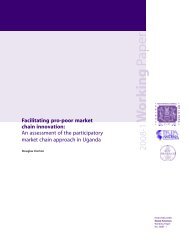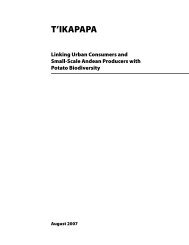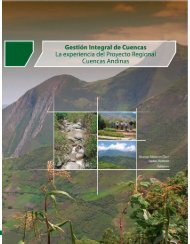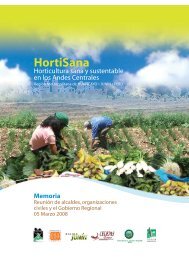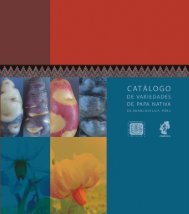Impacts of Urban Agriculture Annual Report.p65 - International ...
Impacts of Urban Agriculture Annual Report.p65 - International ...
Impacts of Urban Agriculture Annual Report.p65 - International ...
- No tags were found...
You also want an ePaper? Increase the reach of your titles
YUMPU automatically turns print PDFs into web optimized ePapers that Google loves.
What should I feed my child?Perceptions <strong>of</strong> foods for young childrenamong Lima mothersWhat types <strong>of</strong> food do people give their children?Are choices made on the basis <strong>of</strong> custom, economy,education – or a combination <strong>of</strong> these? A study wasconducted in a handful <strong>of</strong> communities on the outskirts<strong>of</strong> Lima to determine caregivers’ perceptions and habitsregarding child nutrition, specifically their use <strong>of</strong> animalbasedproducts in the diet <strong>of</strong> young children betweensix and twenty four months old.19The study, carried out jointly in 2003 by <strong>Urban</strong> Harvestand Peru’s Nutritional Research Institute (IIN), is set tohelp develop future programs and educational materialaimed at combating infant malnutrition with anemphasis on incorporating animal-based products suchas meats, milk and eggs into babies’ meals.A vital source <strong>of</strong> protein, vitamins, iron, zinc and calcium,animal-source foods are important for human growthand development, particularly during children’s firstyears <strong>of</strong> life, when mental and physical development ismost rapid and when the incorporation <strong>of</strong> foodscomplementary to breast milk is <strong>of</strong> utmost importance.Access to meat and other animal-based products,however, is limited in rural and peri-urban areas such asthe four shantytowns where the study was carried out,as these products are more difficult and more expensiveto obtain than say, vegetable crops or processed goods.In Peru, <strong>of</strong> the half million children under the age <strong>of</strong> five,one in four suffers from chronic malnutrition and onein every two has anemia—a disorder caused by a dietaryiron or vitamin deficiency.Through this and other projects, the <strong>International</strong> PotatoCenter (CIP) and partner institutions are committed toimproving children’s nutrition and overall health byencouraging mothers to adopt good feeding habits,disseminating information on the health benefits <strong>of</strong>consuming animal-based products, and providingrecommendations on the incorporation <strong>of</strong> suchproducts into daily meals.The methodology used in this particular study includedin-depth one-on-one and group interviews withcaregivers—including home animal breeders—as wellas written surveys and questionnaires. During the initialinformation gathering process, project leaders appliedthe Pile Sort technique, which involves users groupingcards into piles according to specific topics. This simpleand effective information sorting method helpedstructure the content <strong>of</strong> the study.Study results brought to light, among other things,reasons why caregivers prefer one animal-basedproduct over another: the availability <strong>of</strong> such productsand the perception (and current use) <strong>of</strong> these products.Caregivers in these communities generally prefer t<strong>of</strong>eed their children chicken liver, chicken meat, milk andegg as their main source <strong>of</strong> animal-based goods. Fish,chicken meat, and yogurt are the products that they






